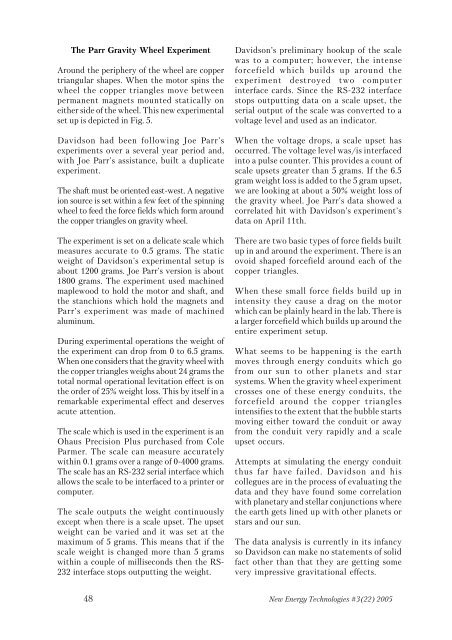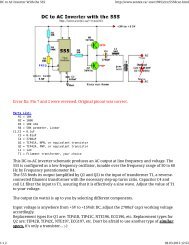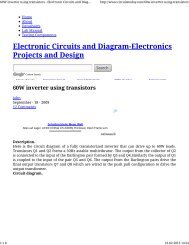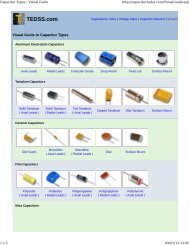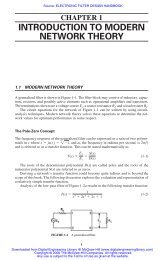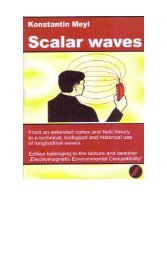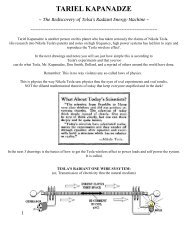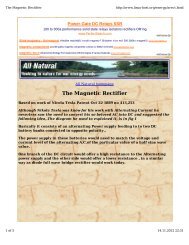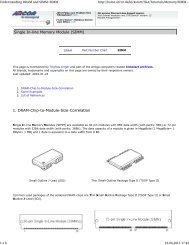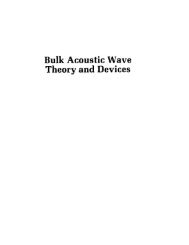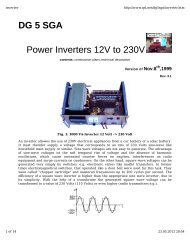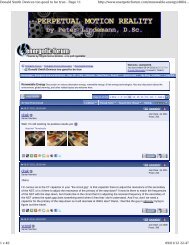New Energy Technologies Magazine nr 3 2005.pdf - Index of
New Energy Technologies Magazine nr 3 2005.pdf - Index of
New Energy Technologies Magazine nr 3 2005.pdf - Index of
Create successful ePaper yourself
Turn your PDF publications into a flip-book with our unique Google optimized e-Paper software.
The Parr Gravity Wheel Experiment<br />
Around the periphery <strong>of</strong> the wheel are copper<br />
triangular shapes. When the motor spins the<br />
wheel the copper triangles move between<br />
permanent magnets mounted statically on<br />
either side <strong>of</strong> the wheel. This new experimental<br />
set up is depicted in Fig. 5.<br />
Davidson had been following Joe Parr's<br />
experiments over a several year period and,<br />
with Joe Parr's assistance, built a duplicate<br />
experiment.<br />
The shaft must be oriented east-west. A negative<br />
ion source is set within a few feet <strong>of</strong> the spinning<br />
wheel to feed the force fields which form around<br />
the copper triangles on gravity wheel.<br />
The experiment is set on a delicate scale which<br />
measures accurate to 0.5 grams. The static<br />
weight <strong>of</strong> Davidson's experimental setup is<br />
about 1200 grams. Joe Parr's version is about<br />
1800 grams. The experiment used machined<br />
maplewood to hold the motor and shaft, and<br />
the stanchions which hold the magnets and<br />
Parr's experiment was made <strong>of</strong> machined<br />
aluminum.<br />
During experimental operations the weight <strong>of</strong><br />
the experiment can drop from 0 to 6.5 grams.<br />
When one considers that the gravity wheel with<br />
the copper triangles weighs about 24 grams the<br />
total normal operational levitation effect is on<br />
the order <strong>of</strong> 25% weight loss. This by itself in a<br />
remarkable experimental effect and deserves<br />
acute attention.<br />
The scale which is used in the experiment is an<br />
Ohaus Precision Plus purchased from Cole<br />
Parmer. The scale can measure accurately<br />
within 0.1 grams over a range <strong>of</strong> 0-4000 grams.<br />
The scale has an RS-232 serial interface which<br />
allows the scale to be interfaced to a printer or<br />
computer.<br />
The scale outputs the weight continuously<br />
except when there is a scale upset. The upset<br />
weight can be varied and it was set at the<br />
maximum <strong>of</strong> 5 grams. This means that if the<br />
scale weight is changed more than 5 grams<br />
within a couple <strong>of</strong> milliseconds then the RS-<br />
232 interface stops outputting the weight.<br />
Davidson’s preliminary hookup <strong>of</strong> the scale<br />
was to a computer; however, the intense<br />
forcefield which builds up around the<br />
experiment destroyed two computer<br />
interface cards. Since the RS-232 interface<br />
stops outputting data on a scale upset, the<br />
serial output <strong>of</strong> the scale was converted to a<br />
voltage level and used as an indicator.<br />
When the voltage drops, a scale upset has<br />
occurred. The voltage level was/is interfaced<br />
into a pulse counter. This provides a count <strong>of</strong><br />
scale upsets greater than 5 grams. If the 6.5<br />
gram weight loss is added to the 5 gram upset,<br />
we are looking at about a 50% weight loss <strong>of</strong><br />
the gravity wheel. Joe Parr's data showed a<br />
correlated hit with Davidson’s experiment's<br />
data on April 11th.<br />
There are two basic types <strong>of</strong> force fields built<br />
up in and around the experiment. There is an<br />
ovoid shaped forcefield around each <strong>of</strong> the<br />
copper triangles.<br />
When these small force fields build up in<br />
intensity they cause a drag on the motor<br />
which can be plainly heard in the lab. There is<br />
a larger forcefield which builds up around the<br />
entire experiment setup.<br />
What seems to be happening is the earth<br />
moves through energy conduits which go<br />
from our sun to other planets and star<br />
systems. When the gravity wheel experiment<br />
crosses one <strong>of</strong> these energy conduits, the<br />
forcefield around the copper triangles<br />
intensifies to the extent that the bubble starts<br />
moving either toward the conduit or away<br />
from the conduit very rapidly and a scale<br />
upset occurs.<br />
Attempts at simulating the energy conduit<br />
thus far have failed. Davidson and his<br />
collegues are in the process <strong>of</strong> evaluating the<br />
data and they have found some correlation<br />
with planetary and stellar conjunctions where<br />
the earth gets lined up with other planets or<br />
stars and our sun.<br />
The data analysis is currently in its infancy<br />
so Davidson can make no statements <strong>of</strong> solid<br />
fact other than that they are getting some<br />
very impressive gravitational effects.<br />
48 <strong>New</strong> <strong>Energy</strong> <strong>Technologies</strong> #3(22) 2005


